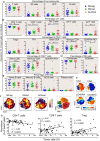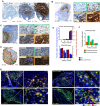Breast cancer metastasis: immune profiling of lymph nodes reveals exhaustion of effector T cells and immunosuppression
- PMID: 34165864
- PMCID: PMC8732351
- DOI: 10.1002/1878-0261.13047
Breast cancer metastasis: immune profiling of lymph nodes reveals exhaustion of effector T cells and immunosuppression
Abstract
Sentinel lymph nodes are the first nodes draining the lymph from a breast and could reveal early changes in the host immune system upon dissemination of breast cancer cells. To investigate this, we performed single-cell immune profiling of lymph nodes with and without metastatic cells. Whereas no significant changes were observed for B-cell and natural killer (NK)-cell subsets, metastatic lymph nodes had a significantly increased frequency of CD8 T cells and a skewing toward an effector/memory phenotype of CD4 and CD8 T cells, suggesting an ongoing immune response. Additionally, metastatic lymph nodes had an increased frequency of TIGIT (T-cell immunoreceptor with Ig and ITIM domains)-positive T cells with suppressed TCR signaling compared with non-metastatic nodes, indicating exhaustion of effector T cells, and an increased frequency of regulatory T cells (Tregs) with an activated phenotype. T-cell alterations correlated with the percentage of metastatic tumor cells, reflecting the presence of metastatic tumor cells driving T effector cells toward exhaustion and promoting immunosuppression by recruitment or increased differentiation toward Tregs. These results show that immune suppression occurs already in early stages of tumor progression.
Keywords: T-cell exhaustion; breast cancer; immune activation; immune profile; metastatic lymph nodes.
© 2021 The Authors. Molecular Oncology published by John Wiley & Sons Ltd on behalf of Federation of European Biochemical Societies.
Conflict of interest statement
The authors declare no conflict of interest.
Figures





References
-
- Bray F, Ferlay J, Soerjomataram I, Siegel RL, Torre LA & Jemal A (2018) Global cancer statistics 2018: GLOBOCAN estimates of incidence and mortality worldwide for 36 cancers in 185 countries. CA Cancer J Clin 68, 394–424. - PubMed
-
- Loi S, Michiels S, Salgado R, Sirtaine N, Jose V, Fumagalli D, Kellokumpu‐Lehtinen PL, Bono P, Kataja V, Desmedt C et al. (2014) Tumor infiltrating lymphocytes are prognostic in triple negative breast cancer and predictive for trastuzumab benefit in early breast cancer: results from the FinHER trial. Ann Oncol 25, 1544–1550. - PubMed
-
- Luen S, Virassamy B, Savas P, Salgado R & Loi S (2016) The genomic landscape of breast cancer and its interaction with host immunity. Breast 29, 241–250. - PubMed
Publication types
MeSH terms
LinkOut - more resources
Full Text Sources
Medical
Research Materials

